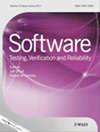组合测试和基于模型的测试
IF 1.2
4区 计算机科学
Q3 COMPUTER SCIENCE, SOFTWARE ENGINEERING
引用次数: 0
摘要
这一期有两篇论文。第一篇论文主要研究组合测试,第二篇论文主要研究基于模型的测试。第一篇论文“测试物联网智能家居系统的组合方法”由Bernhard Garn, Dominik-Philip Schreiber, Dimitris E. Simos, Rick Kuhn, Jeff Voas和Raghu Kacker撰写,提出了一种将组合测试(CT)应用于物联网(IoT)家庭自动化中心系统的内部配置和功能的方法。作者首先创建了物联网家庭自动化中心系统的输入参数模型,用于组合测试的测试生成策略,然后提出了一个自动化测试执行框架和两个测试预言机,用于评估目的。该方法利用适当表述的轮毂模型,由该模型生成满足一定组合覆盖条件的测试集。作者在现实世界的物联网系统上对所提出的方法进行了评估。评估结果表明,所提出的方法揭示了被测设备中的多个错误,并且所有比较方法的性能几乎相同(由w.k. Chan推荐)。第二篇论文,由Robert Sachtleben和Jan Peleska撰写的“部分FSM模型的有效灰盒测试”,探讨了从有限状态机(FSM)进行测试的问题,并考虑了输入可以在某些状态下启用而在其他状态下禁用的场景。已经有大量的FSM测试工作,其中输入并不总是定义的(部分FSM),但是这样的工作通常允许被测系统(SUT)是这样的,一些输入在SUT的状态下定义,而不是在规范FSM的相应状态下定义(SUT可以“更多”定义)。本文引入了一种一致性关系,称为强约简,它要求在规范和SUT中定义完全相同的输入。本文给出了一种新的测试生成技术用于强还原,它返回的测试套件是完整的:如果SUT有故障,测试套件就保证失败,并且还满足了SUT状态数量的上界的某些条件。总体方法还要求测试人员能够确定在SUT的当前状态下启用了哪些输入,因此测试是灰盒测试(由Helene Waeselynck推荐)。本文章由计算机程序翻译,如有差异,请以英文原文为准。
Combinatorial testing and model‐based testing
This issue contains two papers. The first paper focuses on combinatorial testing and the second one focuses on model-based testing. The first paper, ‘Combinatorial methods for testing Internet of Things smart home systems’ by Bernhard Garn, Dominik-Philip Schreiber, Dimitris E. Simos, Rick Kuhn, Jeff Voas, and Raghu Kacker, presents an approach for applying combinatorial testing (CT) to the internal configuration and functionality of Internet of Things (IoT) home automation hub systems. The authors first create an input parameter model of an IoT home automation hub system for use with test generation strategies of combinatorial testing and then propose an automated test execution framework and two test oracles for evaluation purposes. The proposed approach makes use of the appropriately formulated model of the hub and generates test sets derived from this model satisfying certain combinatorial coverage conditions. The authors conduct an evaluation of the proposed approach on a real-world IoT system. The evaluation results show that the proposed approach reveals multiple errors in the devices under test, and all approaches under comparison perform nearly equally well (recommended by W. K. Chan). The second paper, ‘Effective grey-box testing with partial FSM models’ by Robert Sachtleben and Jan Peleska, explores the problem of testing from a finite state machine (FSM) and considers the scenario in which an input can be enabled in some states and disabled in other states. There is already a body of work on testing from FSMs in which inputs are not always defined (partial FSMs), but such work typically allows the system under test (SUT) to be such that some inputs are defined in a state of the SUT but are not defined in the corresponding state of the specification FSM (the SUT can be ‘more’ defined). The paper introduces a conformance relation, called strong reduction, that requires that exactly the same inputs are defined in the specification and the SUT. A new test generation technique is given for strong reduction, with this returning test suites that are complete: a test suite is guaranteed to fail if the SUT is faulty and also satisfies certain conditions that place an upper bound on the number of states of the SUT. The overall approach also requires that the tester can determine which inputs are enabled in the current state of the SUT and so testing is grey-box (recommended by Helene Waeselynck).
求助全文
通过发布文献求助,成功后即可免费获取论文全文。
去求助
来源期刊

Software Testing Verification & Reliability
工程技术-计算机:软件工程
CiteScore
3.70
自引率
0.00%
发文量
34
审稿时长
>12 weeks
期刊介绍:
The journal is the premier outlet for research results on the subjects of testing, verification and reliability. Readers will find useful research on issues pertaining to building better software and evaluating it.
The journal is unique in its emphasis on theoretical foundations and applications to real-world software development. The balance of theory, empirical work, and practical applications provide readers with better techniques for testing, verifying and improving the reliability of software.
The journal targets researchers, practitioners, educators and students that have a vested interest in results generated by high-quality testing, verification and reliability modeling and evaluation of software. Topics of special interest include, but are not limited to:
-New criteria for software testing and verification
-Application of existing software testing and verification techniques to new types of software, including web applications, web services, embedded software, aspect-oriented software, and software architectures
-Model based testing
-Formal verification techniques such as model-checking
-Comparison of testing and verification techniques
-Measurement of and metrics for testing, verification and reliability
-Industrial experience with cutting edge techniques
-Descriptions and evaluations of commercial and open-source software testing tools
-Reliability modeling, measurement and application
-Testing and verification of software security
-Automated test data generation
-Process issues and methods
-Non-functional testing
 求助内容:
求助内容: 应助结果提醒方式:
应助结果提醒方式:


